Choral Societies in the Hungarian Capital
In the 19th century, music societies became the new formations of the changing music scene and the whole of the society on its way towards Embourgeoisement. Among them, the choral societies and the men’s choirs, with their various programs and mass-events, increasingly attracted the focus of attention in the capital, giving more and more space to the creative musical expressions of the self-organizing bourgeoisie.
Secular male choirs, designated as dalárda, dalegylet [lit. song choir, song society], appeared in Hungary already during the 1830s and 1840s, based early-19th-century Swiss and German models. According to our present knowledge, the first choral societies in the capital were founded during the 1840s; their numbers gradually increased over the next two or three decades and they soon became nationally known. With their public appearances regularly covered by the press, their concerts provided an opportunity for discussions related to the choral society movement. Male choirs were present at major events: they took part in the sovereign’s greeting during the imperial visits of 1852 and 1857, contributed to the celebration of the National Conservatory’s twenty-five-year anniversary, and hosted the National Meeting of Choral Societies in 1870. In addition, male choir societies organized evening concerts, dance entertainments, and excursions; engaged military bands in their performances, organized (or participated in) charity concerts, performed at inaugurations, openings, church events; gave serenades on various occasions, greeted archbishops, and through these activities they filled many of the capital’s public spaces. Investigating their activities will give a closer look into the musical and social life in Pest, Buda, and Óbuda in the time of Ferenc Erkel and Ferenc Liszt.
1. Institutionalization
Local press covered the first choral societies in the capital as early as the 1840s. On 20 June 1843, Hazai ’s Külföldi Tudósítások [Domestic and Foreign Reports] reported about a 75-member company, named “Szépjuhászné” [Beautiful Shepherdess] who gave a Lieder-Tafel, i.e. a choral concert and a reception, which – if we are to believe the description – was assisted by ladies. Shortly afterwards, the same paper reported that on 16 July the “Buda Lieder-Tafelists” met again in the Buda Hills for a “beautiful party.” Honderü, also covering this event, called its participants “budai daláregylet (Liedertafel).” In August 1843, Hazai ’s Külföldi Tudósítások already reported that there were several male choirs, of different sizes, in Pest and Buda. On 30 December 1843, Honderü (1/26, 831) reported about the establishment of another choral society, led by of Mr. Dolezsalek, director of the Pest Institute for the Blind. In the following weeks and months, we can follow the fusion of the Concordia Society and the aforementioned choral society, the musical activity of the new society, and the changes of the officers. The next mentions of a choral society in capital occur in the 1850s and are connected to the formation of the Pest-Budai dalárda [Pest-Buda Male Choral Society] and the early years of the Budai Dalárda [Buda Male Choral Society].
The Pest-Buda Male Choral Society was founded in 1854. The organization of Ofner Sängerhort (the later Buda Male Choral Society) began in 1856; the official establishment took place in 1864. The Choral Society of the Royal Hungarian University was founded in Pest in 1861, being officially approved in early 1862. The Pest Union Men’s Choral Society and the Óbuda Dalfüzér [Liederkranz] were founded in 1862, although there are press reports of their formation as early as 1858–1859. Further establishments include the Nemzeti Dalkör [National Men’s Choir] (1865).
Nándor Thill, a church choirmaster in the Lipótváros/Leopoldstadt district of Pest, led between 1852 and 1867 the Pest-Buda Male Choral Society, which developed from a private ensemble he founded himself. According to the records of Viktor Vajda and Kornél Ábrányi, the police kept Thill’s choir under surveillance in the early 1850s, their activities were obstructed, and it was only due to Franz Joseph’s 1852 visit to Hungary that the choral society was finally permitted to operate, as a proper musical representation was needed. This narrative, however, raises a number of questions, concerning its authenticity which has not yet been clarified by research. We do not know, e.g., the reason why – in addition to the National Theatre and other theatrical choirs – there was such an acute need for the members of the Pest-Buda Male Choral Society, who could not have been so numerous. One thing is certain, however: in 1854, the Buda Male Choral Society performed in the Great Hall of the Hotel Europe. Kornél Ábrányi considers Thill to be of outstanding importance for the national choral society movement, and records his society as the first male choir society of the Hungarian capital.
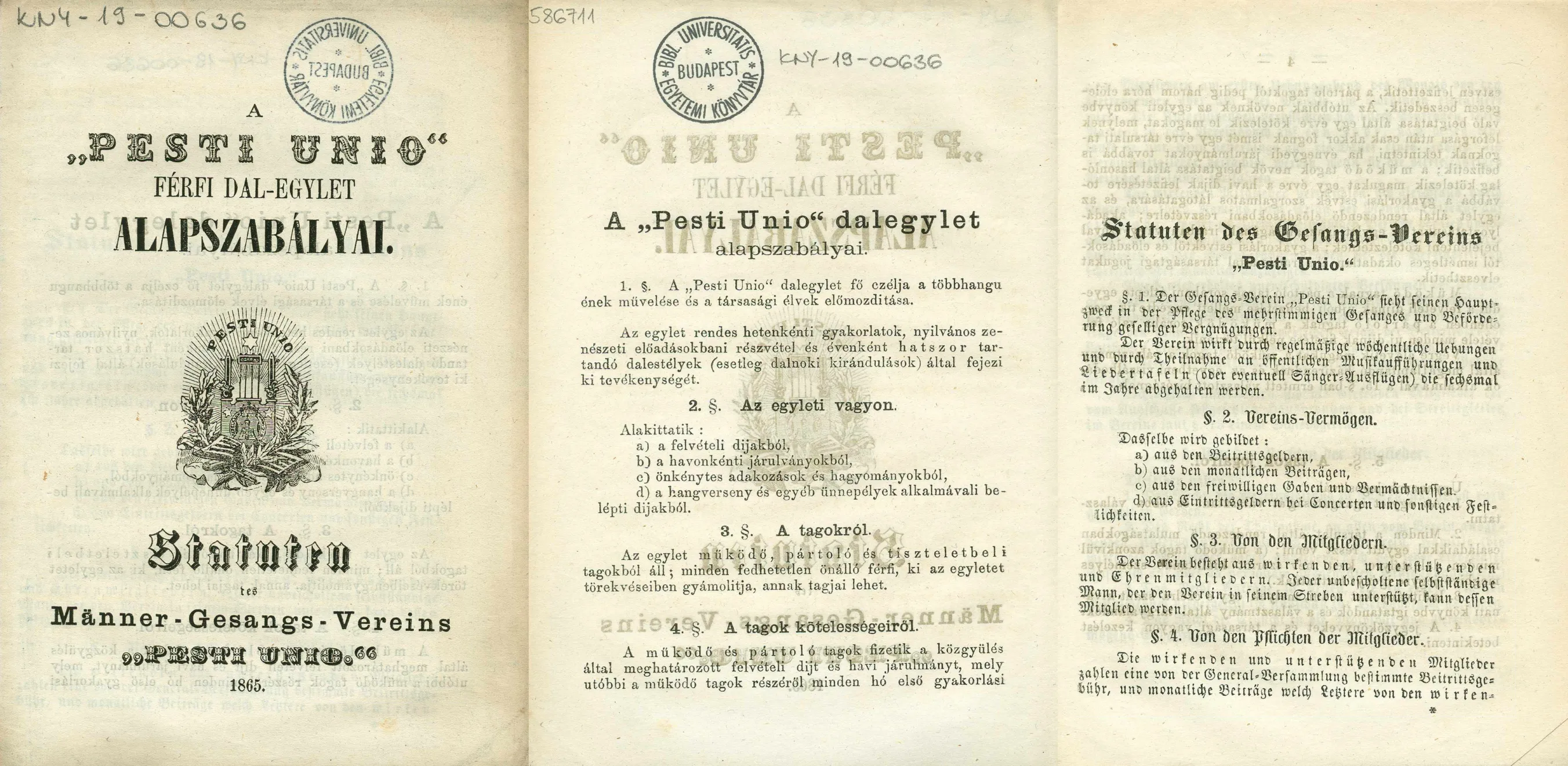
ELTE University Library and Archives, KNY-19-00636
2. Events
The activities of the capital’s choral societies, like those of the choral societies throughout the country, were varied: they held public events, such as evening concerts, festive concerts, choral concerts with dancing entertainments, and charity concerts; they organized semi-public flag-consecration ceremonies, provided church services, but they were also responsible for serenades and private events (excursions). It is typical that a number of solo singers and instrumentalists performed at the concerts of the choral societies, performances in prose, too, frequent appeared on their programs. As relatively few program-notes and other printed materials survive, we are able to reconstruct the performances of the choral societies mainly based on period press reports.
A good example of charity concerts is the 20 July 1867 concert of the Choral Society of the Royal Hungarian University, held at the Lövölde [Rifle Range] to the benefit of the Retired Soldiers’ Fund (Zenészeti Lapok [Musical Journal] 7 July 1867).1 Zenészeti Lapok also covered the event.2
Male choral societies were frequently connected to churches. For example, Nándor Thill, the choirmaster of the Inner City Parish Church, founded the Pest-Buda Male Choral Society primarily for the purpose of church service, as stated in the very first sentence of their statutes from 1858: “The purpose of this society is to cultivate and promote true and good religious singing.” It is not surprising, therefore, that they performed on Good Friday and Easter. To celebrate the society’s anniversary (1866), they performed a Mass at the Inner City Parish Church (Zenészeti Lapok, 28 January 1866).3 To quote another example, on the celebration of the Technical University’s (Műegyetem) Hungarianization (1860), the Choir of the University was invited to sing in Hungarian at the Matthias Church.4
The twenty-fifth anniversary of the National Music Conservatory (August 1865) was outstanding event in the framework of which the Third National Choral Society Festival was held at the Városliget [City Park], following the festivals organized in Sopron and Pécs. In 1870, the National Choral Society Festival took place once again in Pest, but this time the organizer was the Hungarian National Association of Choral Societies.
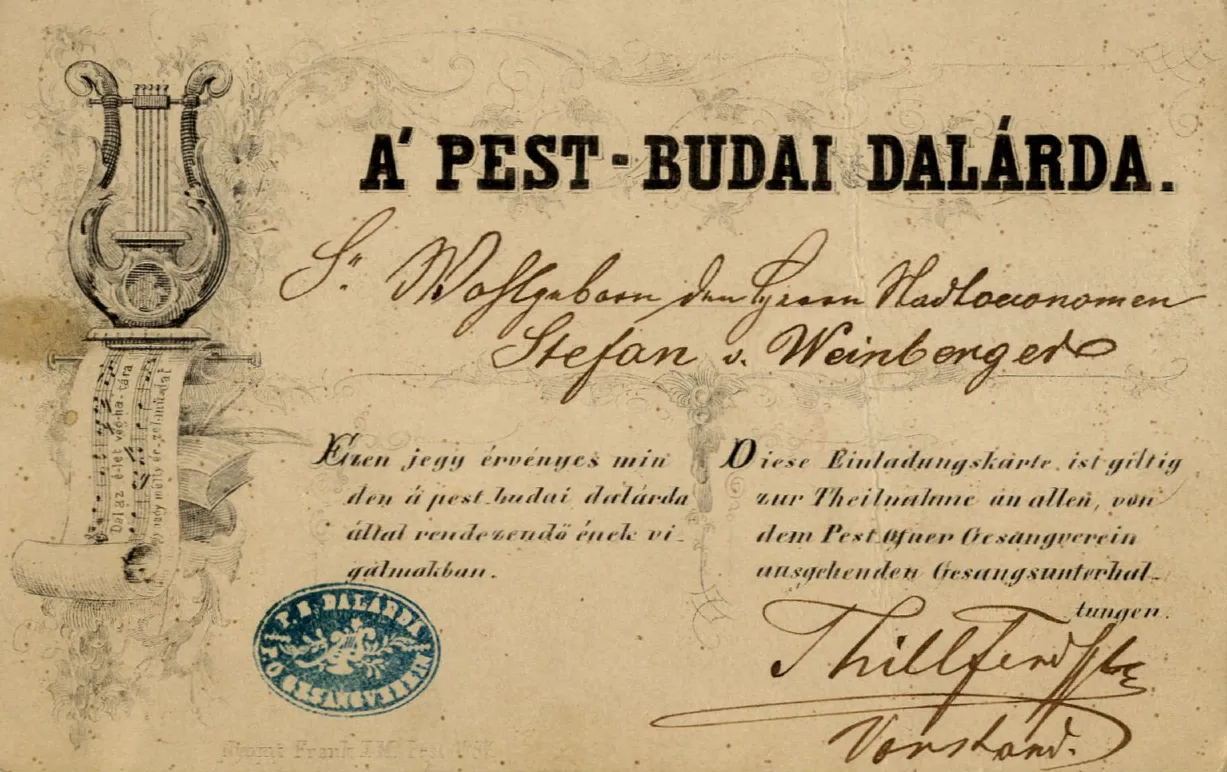
BHM Kiscell Museum, 15851.1
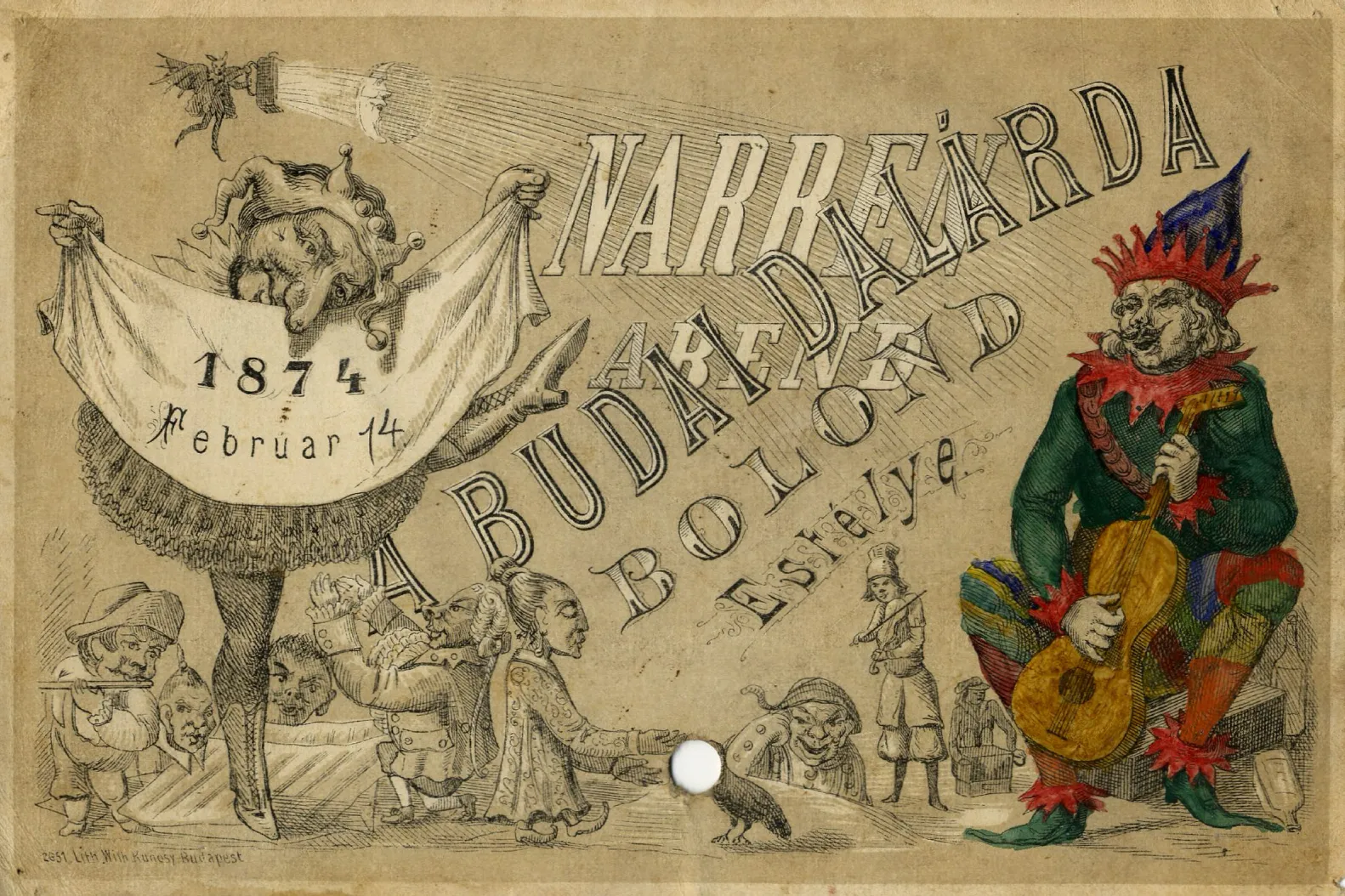
BHM Kiscell Museum, 12846
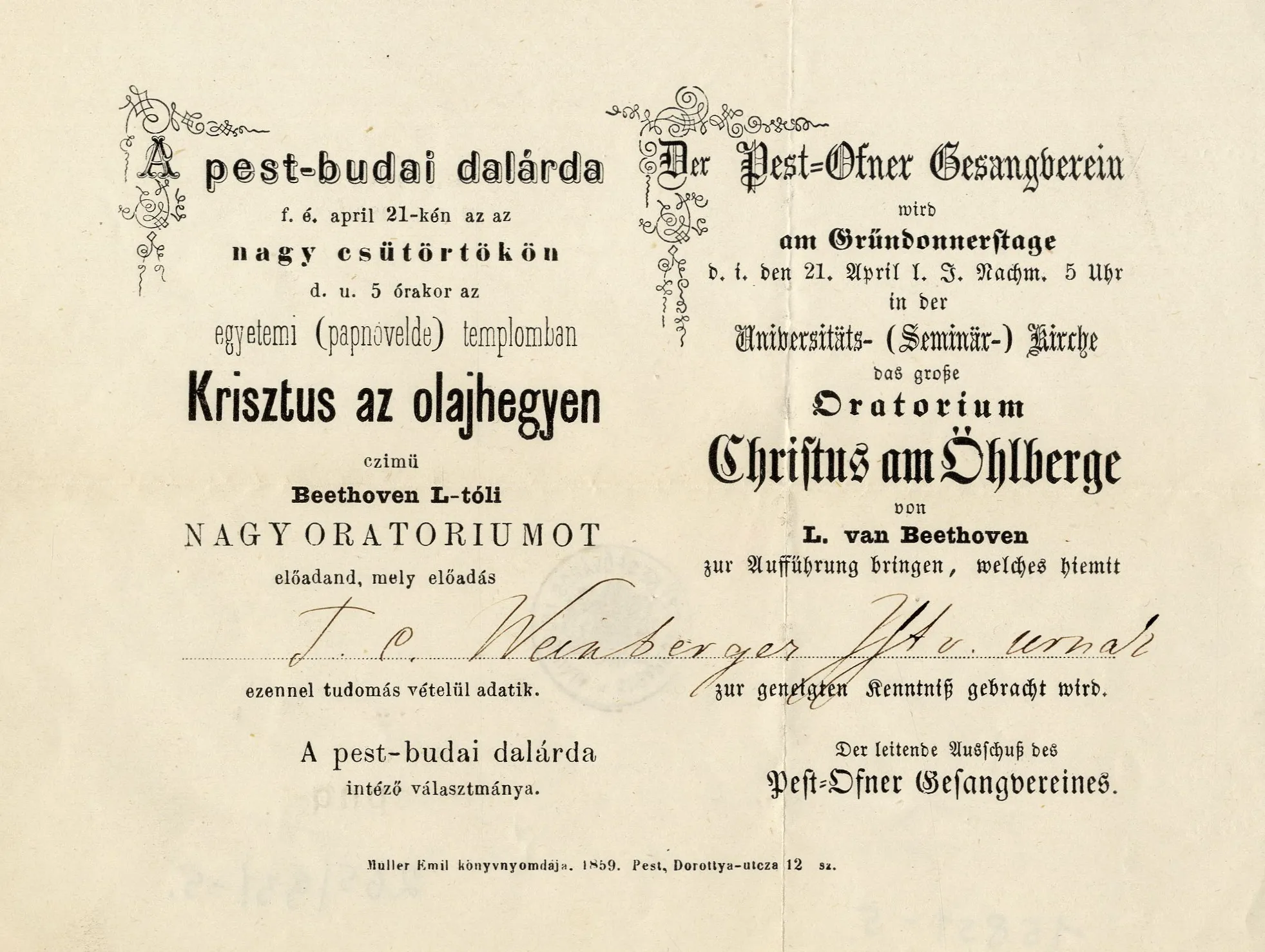
BHM Kiscell Museum, 15851.5
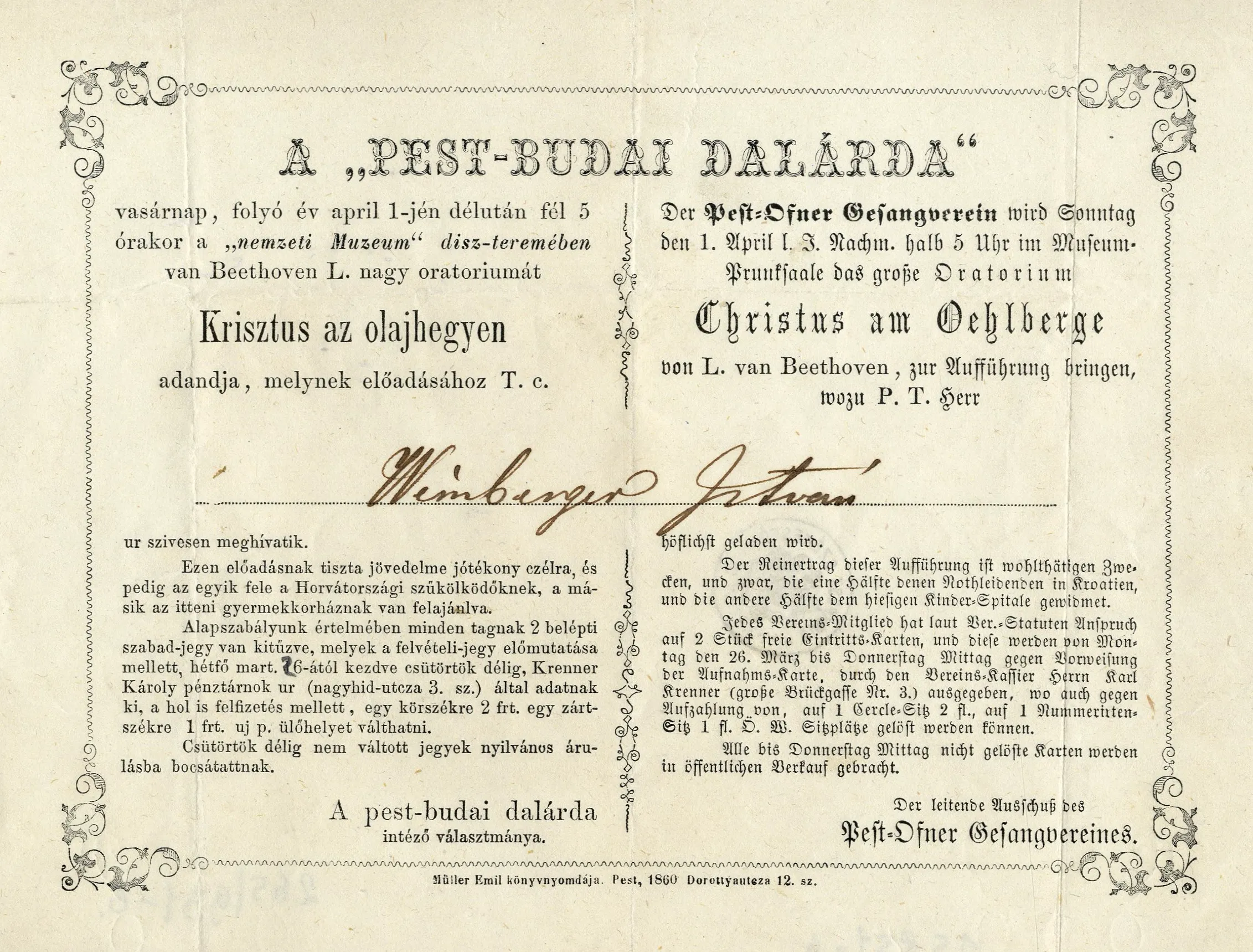
BHM Kiscell Museum, 15851.6
3. Venues
The non-exhaustive, however, still representative list of the venues used for performances and entertainment at the time includes: Hotel Europe, the Tiger Hotel, the Kaiserbad, Zugliget / Fáczán, the garden of the Tüköry beer hall, the restaurant “Steamboat,” the Vigadó (Redout), the Margaret Island, the City Park, and various churches.
Alt-Ofner Liederkranz held its singing exercises on Wednesdays and Fridays at the “Steamboat” restaurant. The Choral Society of the Royal Hungarian University rehearsed on Mondays, Tuesdays, Wednesdays and Saturdays from 6–7 pm at the University. The University viewed the Choral Society as its own, if rehearsals could be held on its premises.
Not all locations were suitable, however. On 27 May 1865, the Buda Male Choral Society had a concert at the Kaiserbad, which was described by Zenészeti Lapok as follows: “The Kaiserbad as a concert location is not an advantageous one from the perspective of its acoustics. At greater distances, the more subtle nuances of the performance were quite blurred.”5
In 1870, Viktor Vajda wrote about the Pest-Buda Male Choral Society: “In 1851, the ensemble had already grown considerably and it happened that some of its members met outdoors in the City Park, on Margaret Island or in Zugliget to perform choral songs from their repertoire to the great delight of the audiences.”6 On the other hand, during the decade of oppression, the 1850s, all group movements were suspicious. According to unconfirmed anecdotes, the police harassed Nándor Thill because members of his men’s choir assembled. It is no coincidence that the statutes of the Pest-Buda Male Choral Society stated: “The President is obliged to report the excursions of the Choral Society and the pieces chosen for performance two days in advance for the Police Department to review them.”
On 21 August 1865, the National Meeting of Choral Societies integrated into the anniversary celebrations of the National Conservatory took place in the City Park, more exactly in the City Park’s shooting range to be precise. By the way, the so-called Polgári Lövölde [Civic Shooting Gallery], which was located on today’s Lövölde Square, was also used as a concert venue by the Union Men’s Choral Society on 1 May 1869. On 26 November 1870, the National Men’s Choir held the dedication of its flag here and they invited Liszt on multiple occasions to their choral soirées at the same location.
A Tüköry-sörcsarnok is kedvelt helyszín volt. Pilsitz Martin így ír róla: „A forgalom növelése érdekében a sörfőzdék gyártóüzemeik közvetlen közelében nagyvonalú sörcsarnokokat kezdtek létesíteni. Ez a különleges vendéglátóipari létesítményt befogadó épülettípus eredeti formájában Magyarországon már nem létezik. A 19. században megszokott városi vendéglőktől és éttermektől méreteiben és felszereltségében is jelentősen különböző sörcsarnokok általában nagyobb parkos kertekben helyezkedtek el. A Tüköry Sörfőzde 1855-ben létesített üzeme mellett saját sörcsarnokot. Ez a mai Szent István körút mentén, feltehetően a Vígszínház helyén működhetett. […] Tüköry sörcsarnokot nagyvonalúan parkosított terület vette körül, ahol feltehetően több kisebb építmény, pl. kút és pavilon is elhelyezésre került. A sörcsarnok körüli területet nyáron sörkertként használták. Ezzel a sörfőzdei létesítmény vonzó városi kirándulóhellyé vált, amely természetesen a vállalat gazdasági érdekeit is megfelelően szolgálta.”7
The Tüköry Beer Hall was also a popular venue. Martin Pilsitz wrote about it: “In order to increase sales, breweries began to build large beer halls in the immediate vicinity of their production facilities. This type of building, which housed a special catering establishment (sörcsarnok / Bierhalle), no longer exists in its original form in Hungary. Beer halls, which differed considerably in size and furnishings from the typical 19th-century urban inns and restaurants, were usually located in large gardens within parks. The Tüköry brewery built its own beer hall next to its factory in 1855. It was located on Szent István körút, probably on the site of Vígszínház [Comic Theatre]. ... Tüköry’s beer hall was surrounded by a large park with several smaller buildings such as a fountain and a pavilion. In the summer, the area around the beer hall was used as a beer garden. The catering establishment of the brewery thus became an attractive urban excursion destination, which of course also served the economic interests of the company.”7 – Martin Pilsitz: “A 19. századi sörfőzdeipar épület- és építménytípusai. Sörcsarnokok, logisztikai központok, jégtavak, jégvermek és hűtőházak” [Building types of the 19th-century brewery industry. Beer halls, logistics centres, ice ponds, ice houses and cold stores] in Architectura Hungariae 15 (2016) 2, 108.
![Iconic scenes of the capital’s Zugliget area, including the „Fácános” [pheasantry].](/images/7-zugliget.webp)
Hazánk és a külföld, 12 September 1867., 585.
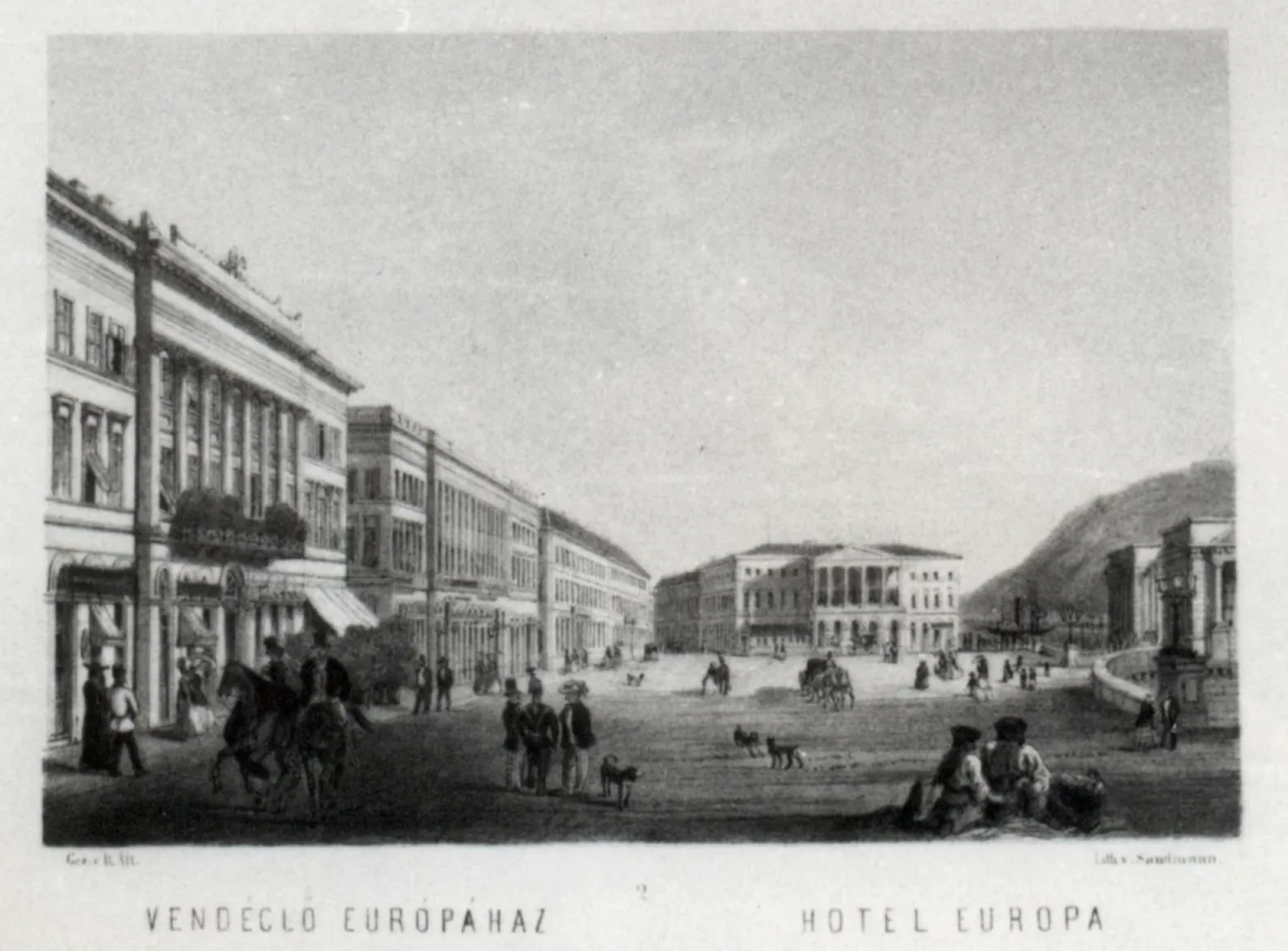
Hungarian Museum of Trade and Tourism, Hungary, CC BY-NC-ND Source
4. Repertoire
One of the greatest contributions of the male choir society movement to Hungarian musical life was the creation of the musical literature for men’s choirs, even if some efforts resulted in works of dubious value. A number of choirs throughout the country announced competitions for the composition of male vocal quartets; the Pest-Buda Male Choir Society was the first one to do so in 1855.8 (In fact, Mihály Mosonyi wrote about them organizing competitions as early as the 1840s, of which we have no further knowledge, nor did a choral society of this name existence at that time, according to our data).
Slogans set to music were the typical genre of the period. Like the society’s flag, they played an important role in the ensemble’s identity and were often used by choral societies to greet each other at their meetings and festivals. Zenészeti Lapok – between January 1869 and October 1872 the official journal of the National Association of Hungarian Choral Societies– published the music for the slogans of several choral societies.
Both Ferenc Erkel and Ferenc Liszt had connections with the Hungarian choral societies. Erkel, who conducted the male singers for the first time in 1865, helped to draft the statutes of the National Choral Association in 1867 and was their “National Conductor” for 14 years from 1868. He also wrote several pieces for them. Hungarian music historiography also considers Liszt as the composer of the first Hungarian-language piece for male choir. Patakcsa, on text by János Garay, 1846, was dedicated to the Pécs male singers, i.e. to the Pécs Male Choral Society. However, apart from the aforementioned choir, Liszt composed only one more work for Hungarian male choirs: A lelkesedés dala [Das Lied der Begeisterung]. Of course, a great number of his other works were sung throughout Hungary.
Another example of the spread of male choral ensembles are the works that various composers dedicated to choral societies. In 1859, the composer and songwriter Gusztáv Nyizsnyai, founder of the Nagykőrös Male Choir Society, dedicated his male choir Nemzeti bordal (National Drinking Song) to the “members of the Pest-Buda Men’s Choir Society as a sign of respect.” It was published as an appendix to the New Year’s issue of Napkelet in 1859.
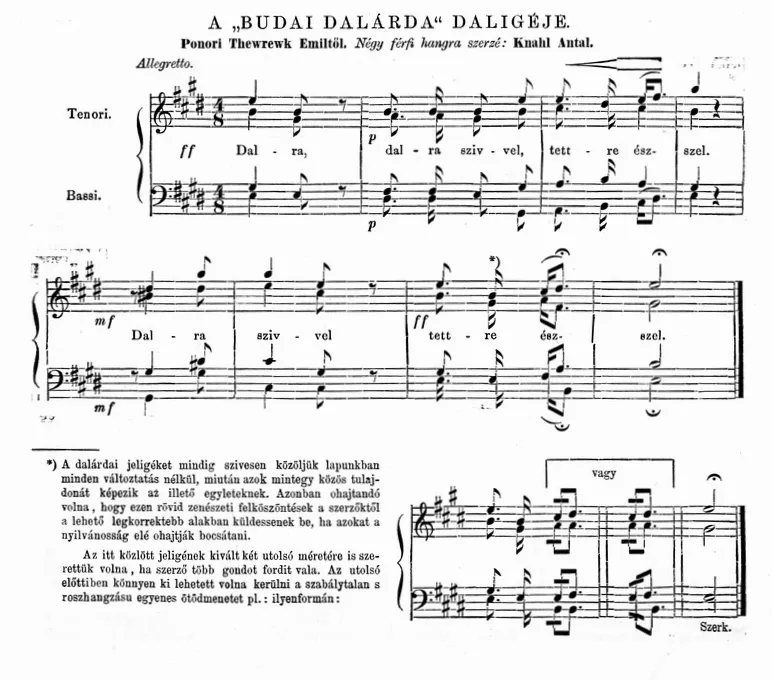
For the manuscript form, see the page on Emil Ponori Thewrewk.
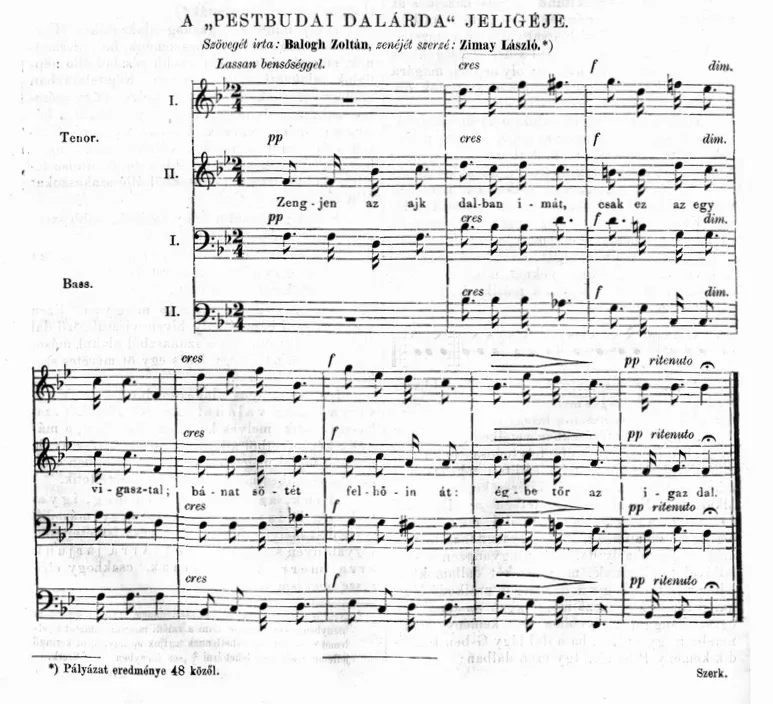

Liszt Academy of Music, Liszt Ferenc Memorial Museum and Research Centre, LH Z 3680. Public domain.
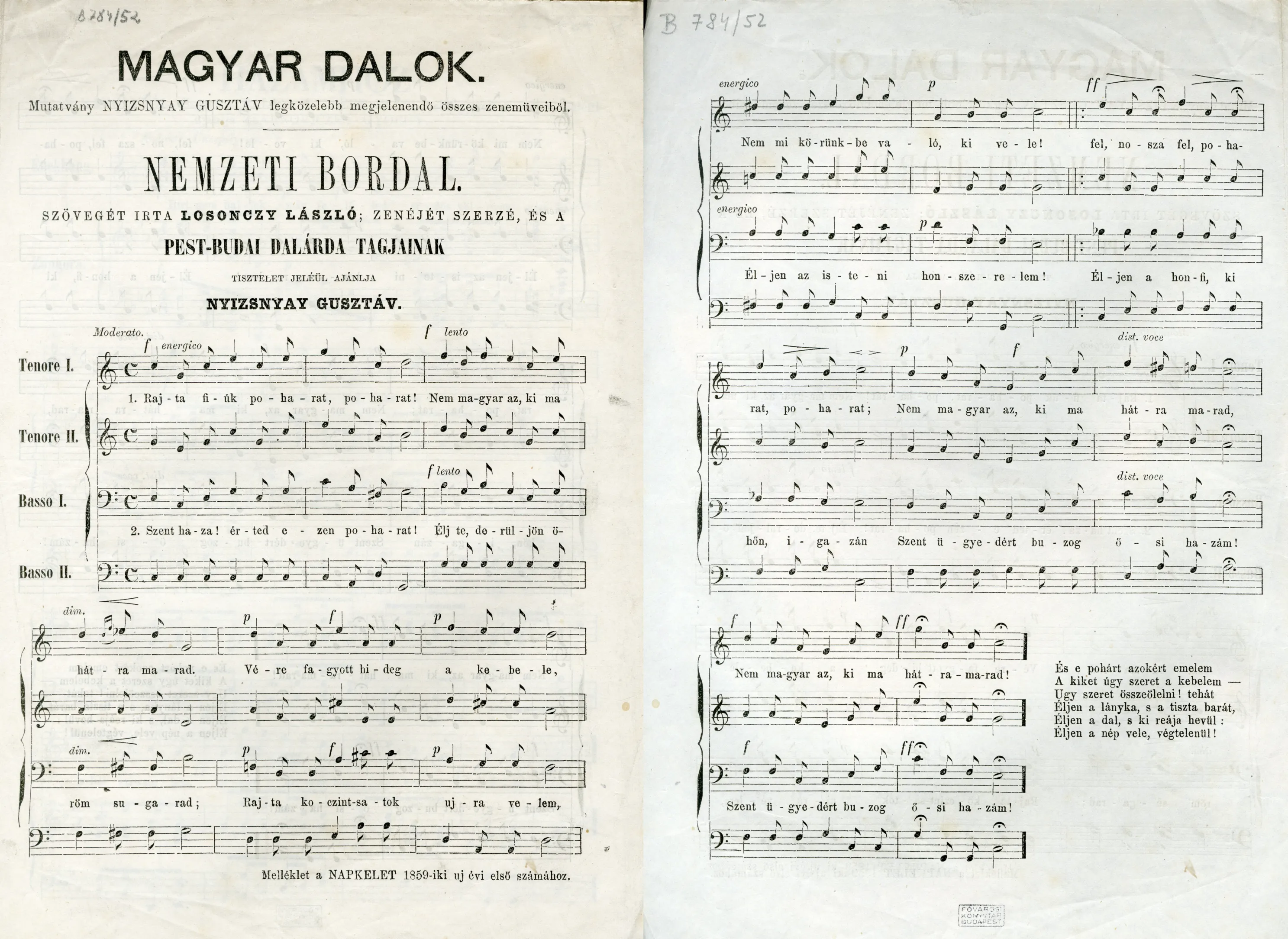
Metropolitan Ervin Szabó Library, Budapest Collection, BZ 784/52. Public domain.
Curated by Rudolf Gusztin
1 Zenészeti Lapok [Musical Journal], 7/40 (7 July 1867), 637.
2 Zenészeti Lapok, 7/43 (28 July 1867.), 685.
3 Zenészeti Lapok, 6/17 (28 January 1866), 134. To read the report, see: Zenészeti Lapok, 6/18 (4 February 1866), 144.
4 Vasárnapi Ujság, 49. szám (2 December 1860), 603.
5 „A budai dalárda 16-ik dalestélye” [The 16th song-evening of the Buda Male Choral Society], Zenészeti Lapok, 5/35 (1 June 1865), 279.
6 Cf. Viktor Vajda: „A magyar dalárdák története” [The history of Hungarian Choral Societies], in Viktor Vajda (ed.): Dalár-emlény a Pest-Budán 1870-ik év aug. 18., 19., 20., 21 és 22-ik napjain tartott orsz. dalár- és zeneünnepély emlékeül [Choral-Memorial ont he Memory of the Choral- and Music Festive held in Pest-Buda on 18, 19, 20, 21 and 22 of August 1870] (Pest, Kertész József, 1870), 50.
7 Martin Pilsitz: “A 19. századi sörfőzdeipar épület- és építménytípusai. Sörcsarnokok, logisztikai központok, jégtavak, jégvermek és hűtőházak” [Building types of the 19th-century brewery industry. Beer halls, logistics centres, ice ponds, ice houses and cold stores] in Architectura Hungariae 15 (2016) 2, 108.
8 Kornél Ábrányi, Sn.: Az orsz. m. daláregyesület negyedszázados története 1867-től 1892-ig [The 25-year History of the Hungarian Choral Society from 1867 to 1892] (Budapest, Orsz. Magy. Daláregyesület, 1892), 13.
